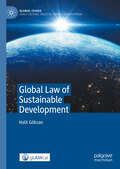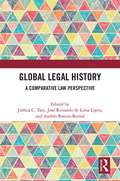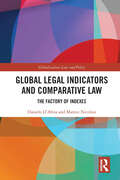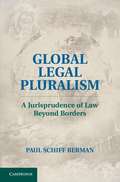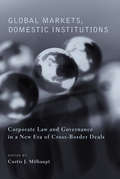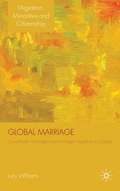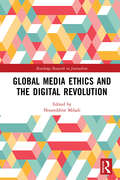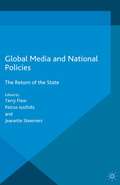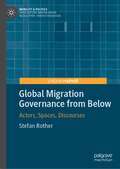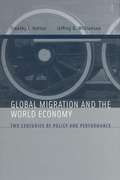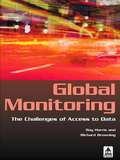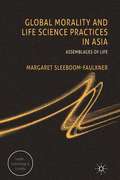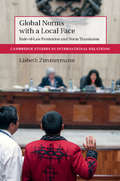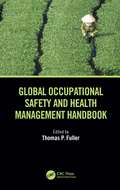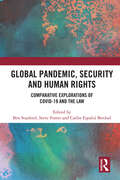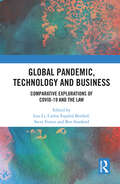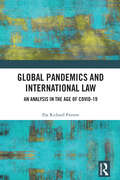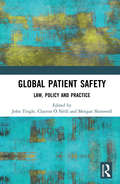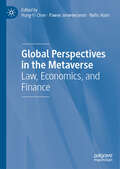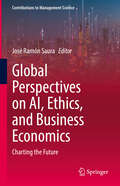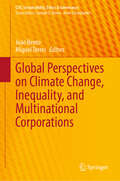- Table View
- List View
Global Law of Sustainable Development (Global Issues)
by Halil GöksanThis book discusses the emergence of a new concept of law at the global level in the field of sustainable development. It examines the four-decade-long evolution of the concept of sustainable development from the Stockholm Conference of 1972 until the adoption of the Sustainable Development Goals in 2015. It brings forward a step-by-step guide for exploring the law-like quality of global norms from a legal positivist and legal pluralist perspective.
Global Legal History: A Comparative Law Perspective
by Joshua C. Tate José Reinaldo de Lima Lopes Andrés Botero-BernalThis collection brings together a group of international legal historians to further scholarship in different areas of comparative and regional legal history. Authors are drawn from Europe, Asia, and the Americas to produce new insights into the relationship between law and society across time and space. The book is divided into three parts: legal history and legal culture across borders, constitutional experiences in global perspective, and the history of judicial experiences. The three themes, and the chapters corresponding to each, provide a balance between public law and private law topics, and reflect a variety of methodologies, both empirical and theoretical. The volume highlights the gains that may be made by comparing the development of law in different countries and different time periods. The book will be of interest to an international readership in Legal History, Comparative Law, Law and Society, and History.
Global Legal Indicators and Comparative Law: The Factory of Indexes (Globalization: Law and Policy)
by Matteo Nicolini Daniele D'AlviaIn recent times, comparative law has moved towards a new type of visualisation of the law, which is mainly based on indexes and indicators. Through these, legal scholars and practitioners measure legal systems against specific benchmarks; they no longer search for commonalities among legal systems but are interested in assessing how the law performs in economic terms. This book critically analyses this ‘quantitative turn’ in comparative law.The work focuses on the role played by social indicators in general, and legal indicators in particular, in contemporary societies. It presents the evaluation of indicators as a pattern of governance as well as a driver promoting a change in the law from ‘outside’. The authors explore a range of issues, including how and why the quantitative turn in comparative law has taken place; how legal indicators are created and for which purposes; whether indicators really act as a new form of legitimisation and law-making and, if so, if it is possible to resist or challenge their power; whether it is fair and equitable to measure the performance of diversified national legal frameworks through such managerial tools of governance; and ultimately, how legal indicators change the way we conceive of the law. The book addresses these issues by focusing on legal indicators, whose global ambitions are often related to societal concerns. To this extent, it examines how both non-economic and economic global indicators might have some bearing on the law.The volume will be of interest to advanced students, researchers, and academics in comparative law, global law, transnational law, constitutional law, and law and economics.
Global Legal Pluralism
by Paul Schiff BermanWe live in a world of legal pluralism, where a single act or actor is potentially regulated by multiple legal or quasi-legal regimes imposed by state, substate, transnational, supranational and nonstate communities. Navigating these spheres of complex overlapping legal authority is confusing and we cannot expect territorial borders to solve all these problems. At the same time, those hoping to create one universal set of legal rules are also likely to be disappointed by the sheer variety of human communities and interests. Instead, we need an alternative jurisprudence, one that seeks to create or preserve spaces for productive interaction among multiple, overlapping legal systems by developing procedural mechanisms, institutions and practices that aim to manage, without eliminating, the legal pluralism we see around us. Global Legal Pluralism provides a broad synthesis across a variety of legal doctrines and academic disciplines and offers a novel conceptualization of law and globalization.
Global Mandatory Fair Use: The Nature and Scope of the Right to Quote Copyright Works (Cambridge Intellectual Property and Information Law #56)
by Lionel Bently Tanya AplinIn a path-breaking work, Tanya Aplin and Lionel Bently make the case that the quotation exception in Article 10 of the Berne Convention constitutes a global, mandatory, fair use provision. It is global, they argue, because of the reach of Berne qua Berne and qua TRIPS, and its mandatory nature is apparent from the clear language of Article 10 and its travaux. It relates to 'use' that is not limited by type of work, type of act, or purpose and it is 'fair' use because the work must be made available to the public, with attribution, and the use must be proportionate and consistent with fair practice. By explaining the contours of global, mandatory fair use - and thus displacing the 'three-step test' as the dominant, international copyright norm governing copyright exceptions - this book creates new insights into how national exceptions should be framed and interpreted.
Global Maritime Transport and Ballast Water Management: Issues and Solutions (Invading Nature - Springer Series in Invasion Ecology #16)
by Matej David Stephan GollaschIn 2015 the first edition of this book was published before the Ballast Water Management (BWM) Convention entered into force. To our knowledge this was and still is the first comprehensive book on BWM worldwide. It provided an overview of possible solutions to the complex issue of BWM. It further outlined consequences and implications to address the ballast water "problem" in line with provisions of the BWM Convention considering environmental, shipping, legal and policy perspectives. The previously addressed subjects remain essential, but new subjects appeared which more recently have proven to be critical for the effective BWM Convention implementation. After the first book content was already agreed and in preparation, new advances were achieved in BWM-related research around the world. Further, new experience was gained and issues came out during the preparation processes of countries for the BWM Convention implementation. The editors of the first book remained heavily involved in BWM-related research and other processes, hence these new critical BWM issues and subjects are now dealt with in the second edition of this book to complement the first one. In essence, this new book covers main issues that arose recently during the implementation of the BWM Convention. Scientists and experts with extensive experience in these subjects from around the globe from academic and private sectors, as well as national administrations, were involved in the preparation of this book.
Global Markets, Domestic Institutions: Corporate Law and Governance in a New Era of Cross-Border Deals
by Ed. Curtis J. MilhauptMarkets for capital, products, and managerial talent are expanding rapidly across national borders, yet domestic laws and practices have never had greater impact on corporate structures and cross-border deals. Investors pursuing high returns and diversification, entrepreneurs seeking capital, and managers endeavoring to restructure troubled enterprises now routinely face transaction counter-parties who operate within different legal and political systems, and who rank social priorities quite differently. This dynamic tension between global markets and domestic institutions fuels the debate on corporate governance reform now raging in virtually every region of the world. It also frames the intellectual agenda of the distinguished contributors to this volume, who examine such issues as the possible convergence of corporate governance practices around the world, national variations in the quality of corporate law, and the fiduciary responsibilities corporate managers around the world owe to their shareholders. Among the book's many insights is the contention that "globalization" and "global markets" are misleading terms, because they mask the local quality of much of the activity occurring within those rubrics. Case studies focus on France, Germany, Italy, Japan, Korea, Taiwan, and the transition economies of Eastern Europe.
Global Markets, Domestic Institutions: Corporate Law and Governance in a New Era of Cross-Border Deals
by Curtis J. MilhauptMarkets for capital, products, and managerial talent are expanding rapidly across national borders, yet domestic laws and practices have never had greater impact on corporate structures and cross-border deals. The distinguished contributors to this volume examine such issues as the possible convergence of corporate governance practices around the world, national variations in the quality of corporate law, and the fiduciary responsibilities corporate managers around the world owe to their shareholders. Case studies focus on France, Germany, Italy, Korea, Taiwan, and the transition economies of Eastern Europe.
Global Marriage: Cross-Border Marriage Migration in Global Context
by Lucy WilliamsThe popular imagination of marriage migration has been influenced by stories of marriage of convenience, of forced marriage, trafficking and of so-called mail-order brides. This book presents a uniquely global view of an expanding field that challenges these and other stereotypes of cross-border marriage.
Global Media Ethics and the Digital Revolution (Routledge Research in Journalism)
by Noureddine MiladiThis volume responds to the challenges posed by the rapid developments in satellite TV and digital technologies, addressing media ethics from a global perspective to discuss how we can understand journalism practice in its cultural contexts. An international team of contributors draw upon global and non-Western traditions to discuss the philosophical origins of ethics and the tension that exists between media institutions, the media market and political/ideological influencers. The chapters then unveil the discrepancies among international journalists in abiding by the ethics of the profession and the extent to which media ethics are understood and applied in their local context/environment. Arguing that the legitimacy of ethics comes not from the definition per se, but from the extent to which it leads to social good, the book posits this should be the media’s raison d'être to abide by globally accepted ethical norms in order to serve the common good. Taking a truly global approach to the question of media ethics, this volume will be an important resource for scholars and students of journalism, communication studies, media studies, sociology, politics and cultural studies.
Global Media and National Policies: The Return of the State (Palgrave Global Media Policy and Business)
by Terry Flew Petros Iosifidis Jeanette SteemersConventional wisdom views globalization as a process that heralds the diminishing role or even 'death' of the state and the rise of transnational media and transnational consumption. Global Media and National Policies questions those assumptions and shows not only that the nation-state never left but that it is still a force to be reckoned with. With contributions that look at global developments and developments in specific parts of the world, it demonstrates how nation-states have adapted to globalization and how they still retain key policy instruments to achieve many of their policy objectives. This book argues that the phenomenon of media globalization has been overstated, and that national governments remain key players in shaping the media environment, with media corporations responding to the legal and policy frameworks they deal with at a national level.
Global Migration Governance from Below: Actors, Spaces, Discourses (Mobility & Politics)
by Stefan RotherAfter a long time of neglect, migration has entered the arena of international politics with a force. The 2018 Global Compact for safe, orderly and regular migration (GCM) is the latest and most comprehensive framework for global migration governance. Despite these dynamics, migration is still predominantly framed as a state-centric policy issue that needs to be managed in a top-down manner. This book proposes a difference approach: A truly multi-stakeholder, multi-level and rights-based governance with meaningful participation of migrant civil society. Drawing on 15 years of participant observation on all levels of migration governance, the book maps out the relevant actors, “invited” and “invented” spaces for participation as well as alternative discourses and framing strategies by migrant civil society. It thus provides a comprehensive and timely overview on global migration governance from below, starting with the first UN High Level Dialogue in 2006, evolving around the Global Forum on Migration and Development (GFMD) and leading up to the consultations for the International Migration Review Forum in 2022.
Global Migration and the World Economy: Two Centuries of Policy and Performance
by Jeffrey G. Williamson Timothy J. HattonThis book is the first comprehensive economic assessment of world mass migration taking a long-run historical perspective, including north-north, south-south, and south-north migrations.
Global Monitoring: The Challenges of Access to Data
by Ray Harris Richard BrowningThis highly technical work is at the leading edge of spatial analysis. It covers the Global Monitoring for Environment and Security (GMES) initiative in the international context of access to environmental data. This book identifies the data policy issues, such as intellectual property rights, privacy, licensing and archiving policies, that affect environmental monitoring organisations, statistical institutes, mapping agencies, institutes for natural resources and Earth observation. It recommends courses of action to improve information services in GMES and assesses the impact of data policy on access to and cost-efficient use of information services in GMES. This title will be essential reading for government institutions such as mapping organisations, space agencies, environmental departments, military and defence departments; it will also be useful to students of environmental policies and industries involved in mapping, cartography, aerial surveys and the space industry.
Global Morality and Life Science Practices in Asia
by Margaret Sleeboom-FaulknerEmpirical studies of life science research and biotechnologies in Asia show how assemblages of life articulate bioethics governance with global moralities and reveal why the global harmonization of bioethical standards is contrived.
Global Norms with a Local Face: Rule-of-Law Promotion and Norm Translation (Cambridge Studies in International Relations)
by Lisbeth ZimmermannTo what extent are global rule-of-law norms, which external actors promote in post-conflict states, localized? Who decides whether global standards or local particularities prevail? This book offers a new approach to the debate about how the dilemma between the diffusion of global norms and their localization is dealt with in global politics. Studying the promotion of children’s rights, access to public information and an international commission against impunity in Guatemala, Lisbeth Zimmermann demonstrates that rule-of-law promotion triggers domestic contestation, and thereby changes the approach taken by external actors and ultimately the manner in which global norms are translated. However, the leeway in local translation is determined by the precision of global norms. Based on an innovative theoretical approach and in-depth study of rule-of-law translation, she argues for a shift in norm promotion from context sensitivity to democratic appropriation, speaking to international relations, peacebuilding, democratization studies, international law and political theory.
Global Occupational Safety and Health Management Handbook
by Thomas FullerThis book was written with the belief that everyone globally has the right to a safe and healthy workplace. An 8-year old carrying bricks in the mid-day sun in Nepal, a pharmaceutical business executive on assignment in Bangladesh, or a mother polishing stone in her home in Tanzania; each has a fundamental right to a workplace free from risk of injury, illness, and death. <p><p> Global Occupational Safety and Health Management Handbook is a broad presentation and discussion of the issues and obstacles facing the Occupational Safety and Health (OSH) profession today in providing safe workplaces globally. Readers can use this book to find resources to assist in the development of their programs and to become informed about the basic structures of international OSH development and governance. Readers can also rely on this book to become more aware of global OSH issues and problems that they may be personally or professionally willing and able to help address. Seasoned OSH professionals can expect to learn about new ways to look at complicated and controversial topics. Young professionals and students can read this book to better understand the important global OSH interrelationships and challenges of the future. <p><p> Features <li>Serves as a one-stop resource for information on important international safety and health topics and issues <li>Provides detailed information about international OSH tripartite, nongovernmental, and professional organizations <li>Describes the various global OSH educational and professional development needs, and international approaches to expanding capacity and awareness of the profession <li>Discusses controversial international OSH working conditions and explains their global impacts
Global Pandemic, Security and Human Rights: Comparative Explorations of COVID-19 and the Law
by Steve Foster Carlos Espaliú Berdud Ben StanfordThis book presents an international and comparative exploration of how the COVID-19 global pandemic has affected and impacted on issues of human rights, security and law. Throughout the world the COVID-19 global pandemic has fundamentally impacted and altered our way of life. As this book sets out, all states have had to contend with similar challenges as well as competing interests and obligations affecting human rights and security. These challenges present very few simple choices but nonetheless carry enormous consequences. Organised into two thematic and distinct, yet interrelated parts, first on theoretical and practical challenges for human rights and second on threats to personal, collective and global security, the book examines how the ability of states to safeguard our fundamental rights and security, broadly defined, has been challenged and that questions about the legality and legal impact of recent responses to COVID-19 will persist for some time. It is often said that global problems require coordinated global solutions, but the various responses to the pandemic by states suggest a notable lack of a consensus amongst the international community. The book will be of interest to academics and researchers working in the areas of human rights law and security law. It will also appeal to constitutional lawyers, given the nature of law-making and the challenge of ensuring adequate scrutiny in emergency situations as well as the impact of COVID-19 upon the legal framework more generally. It will provide a valuable resource for policymakers, practitioners, and public servants.
Global Pandemic, Technology and Business: Comparative Explorations of COVID-19 and the Law
by Luo Li Steve Foster Carlos Espaliú Berdud Ben StanfordThis book presents an exploration of a wide range of issues in law, regulation and legal rights in the sectors of information protection, the creative economy and business activities following COVID-19. The debilitative effect of the global pandemic on information protection and creative and business activities is powerful, widespread and deeply influential, bringing a range of uncertainties to these sectors. The effects of the crisis challenge the fundamentals of the legal systems of most countries in their attempt to govern them. Written by international academics from a diversified background of law disciplines and legal systems, this book offers a global vision in exploring the wide range of legal issues caused by the COVID-19 crisis in these fields. The book is organised into three clear thematic parts: Part I looks at information protection and intellectual property rights and strategies; Part II examines contracts, cooperation and mediation in the post-COVID-19 market arena; and Part III discusses issues pertaining to corporate governance and employment rights. The book explores the unprecedented challenges posed by the pandemic crisis from a global perspective. It will provide invaluable information and guidance in this area to those in the fields of law, politics, and economics whose interests are related to information, business and the creative industry, as well as providing indispensable reading to business practitioners and public servants.
Global Pandemics and International Law: An Analysis in the Age of Covid-19
by Ilja PavoneThis book reviews the efficacy of Global Health Law, assessing why its legal framework based on the International Health Regulations did not represent a valid tool in the containment of modern global pandemics such as COVID-19. The book provides an introduction to the international legal framework surrounding epidemics and pandemics and the main global governance issues that have been generated by the COVID-19 outbreak. It highlights the main shortcomings of Global Health Law, while also including practical proposals to improve the WHO’s mechanism to prevent and respond to future disease outbreaks, such as the New Pandemic Treaty. Emphasis is placed on what has not worked in the international, regional and national responses to COVID-19. It is argued that the pandemic has shed light on the weaknesses of global and domestic health law. By identifying legal gaps and providing legal arguments, the book contributes to the historical and conceptual foundation as well as the practical development of international law in the new age of COVID-19, with the ultimate goal of stimulating legal reform in this vital new era. The work will be essential reading for academics, researchers and policy-makers working in International Law, Health Law, Environmental Law, Human Rights Law, Biolaw, and the Law of International Organizations.
Global Patient Safety: Law, Policy and Practice
by John Tingle Clayton Ó Néill Morgan ShimwellThis book explores patient safety themes in developed, developing and transitioning countries. A foundation premise is the concept of ‘reverse innovation’ as mutual learning from the chapters challenges traditional assumptions about the construction and location of knowledge. This edited collection can be seen to facilitate global learning. This book will, hopefully, form a bridge for those countries seeking to enhance their patient safety policies. Contributors to this book challenge many supposed generalisations about human societies, including consideration of how medical care is mediated within those societies and how patient safety is assured or compromised. By introducing major theories from the developing world in the book, readers are encouraged to reflect on their impact on the patient safety and the health quality debate. The development of practical patient safety policies for wider use is also encouraged. The volume presents a ground-breaking perspective by exploring fundamental issues relating to patient safety through different academic disciplines. It develops the possibility of a new patient safety and health quality synthesis and discourse relevant to all concerned with patient safety and health quality in a global context.
Global Perspectives in Urban Law: The Legal Power of Cities (Juris Diversitas)
by Nestor M. Davidson Geeta TewariThe growing field of urban law demands a collaborative scholarly focus on comparative and global perspectives. This volume offers diverse insights into urban law, with emerging theories and analyses of topics ranging from criminal reform and urban housing, to social and economic inequality and financial crises, and democratization and freedom for individual identity and space. Particularly now, social, economic, and cultural issues must be closely examined in conjunction with the rule of law not only to address inadequate access to basic services, but also to construct long-term plans for our cities and our world—a bright, safe future.
Global Perspectives in the Metaverse: Law, Economics, and Finance
by Nafis Alam Hung-Yi Chen Pawee JenweeranonThe metaverse is undergoing rapid and transformative changes, yet it has thus far lacked a comprehensive scholarly examination from a global and comparative standpoint. The publication addresses existing gaps by introducing fresh perspectives and frameworks across various domains within the metaverse, including law, economics, and finance. Drawing upon the expertise of an international cohort of scholars and practitioners, this volume illuminates emerging interdisciplinary insights with global relevance, facilitating a comparative analysis of diverse aspects of the metaverse. Timely and essential, this book contributes significantly to the metaverse literature, addressing urgent issues in this evolving landscape.
Global Perspectives on AI, Ethics, and Business Economics: Charting the Future (Contributions to Management Science)
by José Ramón SauraThis book offers an in-depth exploration of the complex and rapidly evolving world of artificial intelligence (AI), focusing on its ethical, economic, and business dimensions. It provides a comprehensive analysis that intertwines historical context, philosophical ethics, global economic impacts, regulatory landscapes, workforce dynamics, corporate governance, consumer behavior, data ethics, and the use of AI for the good of society. After reviewing the evolution of AI, it offers insights into its historical milestones and the trajectory it may take in the future. This sets the stage for a broader discussion on how AI is not just a technological phenomenon but also a catalyst for ethical, economic, and societal transformation. The book emphasizes the importance of understanding AI&’s historical development in order to gauge its potential impacts on our future. It examines various ethical theories, including utilitarianism, deontology, and virtue ethics, and their application in the realm of AI. Moreover, it explores how AI is reshaping industries, shifting market dynamics, and transforming the global economic landscape.
Global Perspectives on Climate Change, Inequality, and Multinational Corporations (CSR, Sustainability, Ethics & Governance)
by João Bento Miguel M. TorresComprising a collection of selected research papers, this book discusses the challenges related to climate change mitigation and adaptation. It adds valuable insights into the link between climate change, global inequality, and multinational corporations. Bringing together an international range of prominent authors, this book interests academics, students, and practitioners. It serves as a valuable guide for policymakers in environmental sustainability. This book encourages researchers to think more broadly about the implications of multinational corporations concerning global inequality and climate change. It deepens understanding of how foreign direct investments can contribute to a more sustainable future and overcome environmental challenges.
